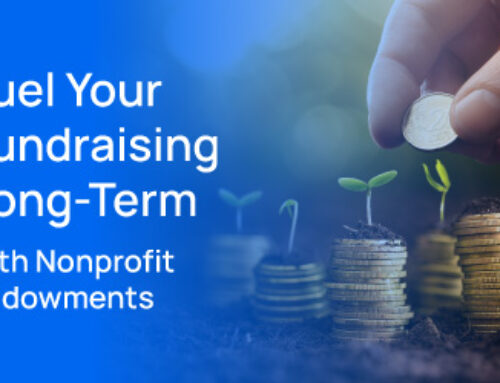
When it comes to reaching your nonprofit’s revenue goals, major gifts are critical. For the average nonprofit, roughly 80% of all revenue comes from only 20% of its donors—and most of these earnings are major gifts.
Because major gifts are so important, it’s crucial to take advantage of any opportunity you have to secure these donations. While your nonprofit likely has an individual or team dedicated solely to moves management and major giving, your marketing efforts can also play a role.
In this guide, we’ll explore how marketing can level up your major gift strategy and some of the most effective strategies to use. Let’s get started!
What role should marketing play in your major gift strategy?
Marketing comes into play during multiple stages of the moves management process. It can boost productivity and help your team allocate its resources effectively. For example, your campaigns should reduce the number of unqualified leads your development team has to sift through.
As Freewill’s guide to major gift fundraising explains, there are four main components to the process. Here’s how marketing can assist with each step:
1. Identification: Pinpoint prospective major donors with the capacity and willingness to donate a major gift. Leverage donor data, segmentation, and targeted communications to identify these leads and direct them to your moves management team.
2. Cultivation: Next, your team will begin to develop a deeper relationship with the prospective major donor. Hyperpersonalized, authentic communication is key at this step. Work closely with your development team to determine which strategies will resonate with the donor.
3. Solicitation: At this point, your organization makes the ask. As a marketer, you may need to supply more personalized marketing materials or help the development team adjust your case for support to align with the donor’s preferences.
4. Stewardship: This stage involves keeping the relationship alive and strengthening your connection with the donor. Be sure to share genuine, personal thank you messages that greet the donor by name, reference the specific ways they are supporting your mission, and report on the impact their gift will make. Continue sending tailored messages to keep the donor engaged in your work.
Keep in mind that this process is rarely linear. If you retain a major for many years, you’ll need to cycle between steps three and four repeatedly to continue securing donations and building the relationship. During these times, keep your marketing efforts focused and aligned with donors’ preferences—this means sharing messages at their preferred frequency and through the platforms they use most often
What are some marketing strategies that promote major gifts?
1. Segment and prioritize your donors.
Data will help your nonprofit qualify major donor prospects. During this step, your organization will need to determine whether the donor is able and willing to make a major gift—but you’ll also need to prioritize donors based on factors like how much they could give, the likelihood of them making a gift, and the timeline for receiving the donation.
Segmenting your donors based on certain characteristics will help you prioritize them and dictate what kinds of marketing messages you share with them. Some donor segments to consider include:
- Giving capacity, or how much donors would be able to donate. Determine this using data like net worth, real estate ownership, stock holdings, and more.
- Philanthropic activity, including donations to other charitable organizations, political contributions, or gifts to their alma mater that could reveal more about their values.
- Engagement level, or how much they interact with your organization. They may be active participants who attend every event or more passive donors who prefer to support you from the sidelines.
- Their relationship with your organization, particularly the length and strength of the connection. For example, you would treat a five-year donor differently than a new prospect.
Many of these details can also reveal why donors give. For example, when your humane society digs into a donor’s past philanthropic involvement, you might find that they help fund a vet clinic in a developing nation. Use this information to strengthen your communications and appeals. In this case, you could make them aware of your organization’s efforts to provide free veterinary services to the community.
2. Send personalized communications.
There are so many ways to personalize your messages, but be sure to make a strong first impression by greeting donors using their preferred names. Then, use your donor segments to create tailored communications that closely align with their preferences and expectations. For example, Allegiance Group + Pursuant recommends using postcard mailers for donors who prefer traditional media but still care about sustainability.
Here’s how you can use the donor segments from the previous section to personalize your message:
- Align asks with giving capacity. Highlight involvement opportunities that match the donor’s budget. Make sure to focus on the larger impact this support would have (e.g., “By funding our new building, we’ll help twice as many people!”).
- Target philanthropic interests. Using what you know about donors’ philanthropic interests and giving motivations, spread awareness of projects or initiatives that align with their values. For example, if your after-school club has a donor who is passionate about childhood literacy, they may want to volunteer to read to the kids one afternoon.
- Respect their engagement level. While you can slowly boost engagement over time, it’s important to respect donors’ boundaries. Highly engaged donors will likely be accepting of more frequent communications and appreciate invitations to events or volunteer opportunities. More passive donors might be more comfortable with updates about your work.
- Recognize where your relationship is at. For long-term, loyal donors, you’ll need to focus more on the importance of sustained support. Recognize their loyalty, and find creative ways for them to deepen their involvement. Newer donor relationships, however, benefit from more educational content about the history of your organization and its work.
Carefully track these interactions with donors, and share them with your development team. This way, they can address any questions or concerns the donor has, follow up with them in face-to-face meetings, and identify opportunities to strengthen the relationship or earn support.
3. Craft stewardship campaigns.
Identifying promising prospects, qualifying them, and cultivating relationships with them is hard work. That’s why it’s so important to retain your major donors and maintain these relationships. While your moves management team is responsible for personally thanking donors via phone calls, handwritten letters, and in-person meetings, you can complement their efforts with your digital marketing outreach.
Creating dedicated stewardship campaigns gives your nonprofit more opportunities to express gratitude, follow up with impact metrics, and keep the relationship positive. Start with more intimate, one-on-one communications like emails or digital greeting cards. Use the data you have on file to greet the donor and thank them for the specific way they supported you. Additionally, you can acknowledge specific personal milestones like their birthday to show that you care about them as a person.
If the donor is comfortable with public recognition, you can also incorporate ideas like digital donor walls into the campaign. These walls consist of large screens that highlight the support and impact of specific donors. You might also recognize these donors on social media, interview them for your newsletter, feature their names in your annual report, or even name the project after them.
The Bottom Line
With the help of major gifts, your nonprofit can reliably hit even its most ambitious fundraising goals. However, soliciting these large donations is a team effort that involves collaboration with your moves management team, data-driven decision-making, and calculated communications. Power up your marketing efforts using donor data to make the most of every major gift opportunity that comes your organization’s way.
About the Author

Liz Murphy is an EVP at Allegiance+Pursuant Group, a direct response fundraising agency and technology company. Liz has more than 30 years of experience growing digital and integrated fundraising and communications programs for social justice, health, and international relief nonprofit organizations.
Liz is an award-winning copywriter and is a frequent speaker at industry conferences, including ANA, DMAW, Bridge, and NTC. She is also a member of the Board of Directors of the Direct Marketing Association of Washington Educational Foundation.





